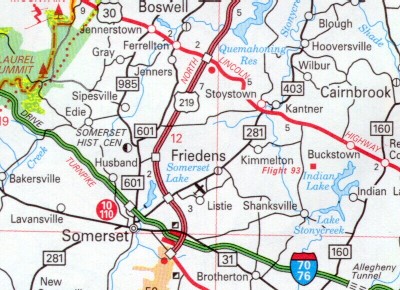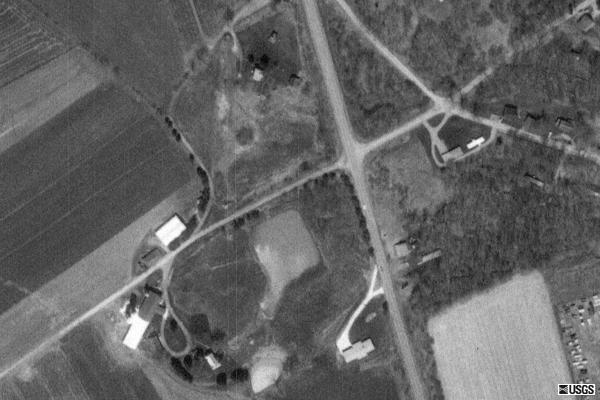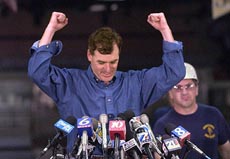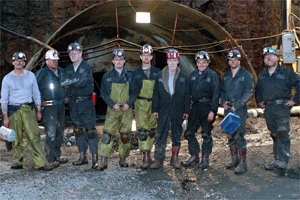
Quecreek Mine Accident

Quecreek Mine Accident
 Location of Sipesville. (PennDOT) |
 Aerial picture of the rescue site, at the top-left section of the four way intersection. |
The summer of 2002 seemed to be like any other summer. The "dog days" of the season were begging to rear their ugly head, and most people looking up to see if any relief was on the way. However, come July 24, most of the United States if not the world would be looking down.
At 8:50 PM on Wednesday, July 24, nine miners working the second shift in the two-year-old Black Wolf Coal Company's Quecreek Mine, just west of that borough, broke through into the Saxman Mine which they thought was 300 feet from where they were mining. Usually it would not be a problem, but the mine held an unseen danger: water. That mine had not be active for decades, and so groundwater had managed to fill the cavern. After the ground separating the two mines was breached, the 50 to 60 million gallons of water began to pour into the Quecreek Mine trapping the nine men working the late shift 240 feet below the fields of Dormel Farm.
Luckily before the water cut them off from the outside world, Dennis Hall managed to phone the other group of nine miners that his group was being inundated with water and to get out. That group got out in time and alerted mine and emergency officials at around 9:53 PM Wednesday night. Between 11:30 PM and 12 AM, calls were made to find a drill that could bore a hole big enough to raise men from a mine, and one was located in Clarksburg, West Virginia. The first course of action was to drill a hole down to the pocket where the trapped miners went to escape the water, and pump compressed, warm air to fight back the water and the 55 degree temperatures. The site was picked from data Bob Long, an engineer technician for Civil Mining Environmental Engineering, Incorporated of Somerset, gathered using GPS sensors. As soon as that drill broke through, the miners began tapping on the shaft and on roof bolts to signal the surface. Another hole was drilled to pump out the water that was endangering them.
"We're going to do it...We're going to succeed," said Mark Zambanini, Fire Chief of the Sipesville Fire Company, which was only a mile up PA 985 from the mine. The drilling was kept out of sight for the most part, but state troopers still had to shoe rubbernecking motorists past the Haupt Road intersection. That was where the "super drill," that was sent with police escort up from West Virginia, was churning a 30-inch wide hole through the western Pennsylvania ground racing the clock to save the nine below. The drilling commenced at 7:30 PM on July 25, and was originally projected to take 18 hours, but workers slowly backed away from that number as the drilling continued.
All was progressing well until the morning of July 26 when the drill bit broke at 1:05 AM at the 105 foot mark. "We've had a setback," Governor Mark Schweiker said. "We've got quite a ways to go." A replacement was flown to the site by helicopter, as crews were fishing the other bit out of the rescue shaft which wouldn't be extricated until 4:45 PM. In fact, the rescuers contacted the company my mother worked for at the time, Kennametal, to see if they made a bit or could fashion one to continue the drilling. They did not make such a tool, but none was needed as drilling got back on track with the replacement drill bit as well as a back-up shaft that was being drilled when the other was clogged. However, hearts dropped as no one heard any tapping coming from the mine below since 12 PM on Thursday, July 25. Then at 3 PM, seismic equipment that was brought in by Federal mining officials detected sounds emanating from the ground.
As the drilling continued, up to 150 relatives of the trapped miners gathered at the Sipesville Volunteer Fire Department two miles north of the mine location. On the afternoon of the 25th, they were taken to the mine and instructed on the rescue effort. Governor Schweiker met with the relatives after visiting the site that night, and said at a news briefing later that they "are in a very fragile state. We may need a little help from the Almighty." He went on to say, "We are bringing every asset that is necessary to complete this rescue operation. I know I speak for Pennsylvanians everywhere in saying we are concerned and offer our heartfelt support."
Time continued to tick away, and with each passing hour the chances of survival became less and less. Pennsylvania Department of Environmental Protection Secretary David Hess said, "It's a very ticklish situation we're in, very touch and go." This was in the "home stretch" of the rescue, with only a few more feet to cut through until the mine ceiling was breached, which might burst the air pocket that was created to hold the water back and supply the miners with oxygen.
By Saturday, July 27, both rescue shafts were measured to be 180 feet down. Still no clear signal from the miners had been heard since the last was heard midday on Thursday. Don Bowman of Gene Yost Drilling Company of Mount Morris, said that despite the setbacks and the tiring work, the crews' morale was high. "We're just doing what it takes to get the job done and we hope that it turns out all right," he added. A positive sign was preparation work continuing on the rescue capsule that would be lowered down the shaft to the miners.
 By
10:15 PM, the drill broke through to the mine, and workers began to prepare a
capsule containing food and a telephone to be sent below. Shortly after that was sent down,
contact was made with the miners. The ordeal was drawing to a close.
At 11:27 PM, Governor Schweiker with his fist raised in victory, came to the
empty Giant Eagle supermarket that had become the media briefing area, and told the
state, nation, and the world what everyone wanted to hear: all nine men
were alive. "Nine for nine," he said, which became a slogan
during the rescue effort. Cheers went up at the media center and as well
at the actual site. Schweiker went on to tell reporters, "They're
eager to come up."
By
10:15 PM, the drill broke through to the mine, and workers began to prepare a
capsule containing food and a telephone to be sent below. Shortly after that was sent down,
contact was made with the miners. The ordeal was drawing to a close.
At 11:27 PM, Governor Schweiker with his fist raised in victory, came to the
empty Giant Eagle supermarket that had become the media briefing area, and told the
state, nation, and the world what everyone wanted to hear: all nine men
were alive. "Nine for nine," he said, which became a slogan
during the rescue effort. Cheers went up at the media center and as well
at the actual site. Schweiker went on to tell reporters, "They're
eager to come up."
As the governor briefed the media outlets on the concluding activities, workers continued to ready things at the mine site. First, the drill bit had to be removed from the shaft and then the crane that would lower the rescue capsule would be moved into place. While that was taking place, so was a fleet of nine medical helicopters and another nine Pennsylvania National Guard helicopters were readied to ferry out the injured. Governor Schweiker made his way to the site to be there for all nine extractions, and said to the rescue workers, "Hey, it's game time, who's good to go?" Everyone resounded a yes. The miners chose the order in which they would come up, and they did so in 10 to 15 minute intervals in this order:
Probably the loudest sigh of relief came from the populace of Somerset County. Not even ten months after United Flight 93 crashed into that now sacred reclaimed strip mine, 11 miles from the Quecreek Mine, another disaster was unfolding within the county. Geneanne Muro, a clerk at the Shanksville convenience store, Ida's, said, "There are people saying it's too much, why's it happening here again?" The Quecreek ordeal did draw the attention of families of several Flight 93 victims who sent the miners' families e-mails of support. "During our time of tragedy," the Flight 93 families said, "you extended yourselves to us and tirelessly continue to do so. We consider you our family and we sincerely hope and pray that the recovery effort will be successful in bringing your loved ones home." Somerset County Coroner Wallace Miller, whom had not dealt with a case that involved more than two fatalities until September 11, was prepared for the worst. "That," he said, "is what I do."
On August 5, a little over a week after the accident and rescue, President George Bush met with the miners. He presided over the event at the Green Tree Volunteer Fire Department. He said, "Today we're here to celebrate life, the value of life, and as importantly, the spirit of America." His speech to the crowd went on to say, "What took place here in Pennsylvania really represents the best of our country, what I call the spirit of America, the great strength of our nation."
Even though extensive investigations have been conducted, still no word has come out as to the reasons for the accident. Most fingers are pointed at antiquated mine maps, that should have been in a museum instead of on file at the mine office. There had been an earlier accident, on October 17, 2001, when according to the Pennsylvania Bureau of Deep Mine Safety, when a 40-by-30-foot section of a mine ceiling collapsed. Thankfully, no one was injured in that accident.
A sad post-script to this story was the suicide of Bob Long, who pinpointed the area for rescue crews to drill. He, like the miners, received $150,000 from the Walt Disney Company for the TV movie and book about the rescue. This caused a break in relations between him and the families, which his father Wally Long said weighed heavily on Bob. He didn't know if this played a role in his son's suicide, as he said Bob had other problems.
The Sipesville Volunteer Fire Department is selling commemorative merchandise to fund construction of a new fire hall. You can order at http://www.sipesvillefire.com/merchandise.html or call 814-443-1356.
To prevent similar accidents from occurring, the Mine Safety and Health Administration is asking anyone with an old mine map to send it to the MSHA. If you have one, call 1-888-753-9427. All maps will be returned.
Quecreek Mine Rescue Memorial
Open: Daily 8 AM - 8 PM (site) Tuesday -
Saturday; Daily 11 AM - 5 PM (museum) Tuesday - Saturday
Website: http://www.quecreekrescue.org/
The Movie: The Pennsylvania Miners' Story
 Just a little
over two months after the rescue took place, Touchstone Pictures began filming a
made-for-TV movie based on the event. I was lucky enough to land a small
role in the picture. However, there are no small roles, only small
people. I was a part of the group gathered in the Sipesville Fire Hall
with the "families," of which I was a member of Dennis Hall's, awaiting word on the rescue. I worked for
four days from September 19 to 20, and 22 to 23 of 2002, and for an average of
ten hours per day. Movies might look like easy work, but it is
grueling. Being my first film, I was honored to be in this one since the
story it is based on occurred only 23 miles from where I live. Also, it
was a great pleasure to be in a film along side John
Ratzenberger, whom I grew up watching on Cheers as mailman Clifford C.
Clavin. What can I say, I am a child of the 80s.
Just a little
over two months after the rescue took place, Touchstone Pictures began filming a
made-for-TV movie based on the event. I was lucky enough to land a small
role in the picture. However, there are no small roles, only small
people. I was a part of the group gathered in the Sipesville Fire Hall
with the "families," of which I was a member of Dennis Hall's, awaiting word on the rescue. I worked for
four days from September 19 to 20, and 22 to 23 of 2002, and for an average of
ten hours per day. Movies might look like easy work, but it is
grueling. Being my first film, I was honored to be in this one since the
story it is based on occurred only 23 miles from where I live. Also, it
was a great pleasure to be in a film along side John
Ratzenberger, whom I grew up watching on Cheers as mailman Clifford C.
Clavin. What can I say, I am a child of the 80s.
I was fortunate to meet three of the miners during the last day of filming: Blaine Mayhugh, Thomas Foy, and Mark Popernack. I spoke with Thomas Foy for a good period of time. I asked him what they went through down in the mine and what they were thinking as they heard the drill churning through the ground on the way to save them. I mentioned how this rescue seemed almost to make up in some way for not being able to save the passengers of United Flight 93. He agreed. Even then Governor Mark Schweiker said of the comparison during the rescue effort: "Perhaps the difference now is that we have the opportunity to rescue people," he said. "After September 11, we didn't."
The movie made its debut on the ABC television network on November 24, 2002, and was replayed on July 27, 2003 to mark the one year anniversary of the miracle rescue. Below are the scenes I was in.

|
Talking with a group of people as
unofficial mine spokesman John Weir (Gareth Williams) begins to tell us the reason we have been summoned to the Sipesville Fire Hall. (Touchstone Television) |

|
Governor Schweiker (Robin
Thomas) comes to
the fire hall to meet with the families. (Touchstone Television) |

|
Even the former company car has a cameo, even
though you can't see the license plate/site logo. (Touchstone Television) |

|
A somber event as the wives of the miners
hold a candle-light vigil. (Touchstone Television) |

|
The celebration begins as word comes that
all nine miners are alive. (Touchstone Television) |

|
Watching the first miner, Randy Fogle (Graham
Beckel), being pulled to safety. (Touchstone Television) |

|
The
Pennsylvania Miners' Story We all know how it ended, but see how the story progressed from the moment the Saxman Mine was breached to the rescue of all nine miners. |
|
|
|

|
Our Story: 77 Hours That Tested Our
Friendship and Our Faith edited by Jeff Goodell (2002) A story that also took place in Somerset County, but had a different outcome than that of Flight 93. For three days, the county and world watched and wondered how the nine miners trapped under the Pennsylvania countryside would, or if at all, be rescued. |
|
|
|
 |
Pennsylvania Disasters: True
Stories of Tragedy and Survival Covers all disasters, natural and man-made, that have befallen the Commonwealth from the Yellow Fever Epidemic of 1793 to the Quecreek Mine Accident of 2002. This page is cited under the Quecreek Mine Rescue section in the Bibliography. |
 AREA LODGING
AREA LODGING |
|
| Somerset | |
Links:
Miracle Miner Community
Foundation
The Miracle
at Quecreek - WPXI-TV Pittsburgh
The
Miracle at Quecreek Mine - Mountain John
The Pennsylvania
Miners' Story - Internet Movie Database
Remembering Quecreek
- KDKA-TV Pittsburgh
Sipesville Volunteer
Fire Department
The Quecreek
Mine Disaster - Lionel Deimel
The
Quecreek Mine Rescue - Pittsburgh Post-Gazette
Quecreek Miner Miracle - CNN
Quecreek
Mining Accident - Pennsylvania Department of Environmental Protection